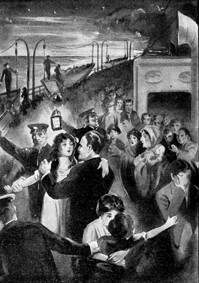Southampton Farewell

Never had a voyage had a more successful beginning than when the Titanic, newly crowned empress of the seas, steamed majestically out of the port of Southampton at noon on Wednesday, April 10th, 1912, bound for New York.
Elaborate preparations had been made for her maiden voyage. Crowds of eager watchers gathered to witness the departure, all the more interested because of the notable people who were to travel aboard her. Friends and relatives of many of the passengers were at the dock to bid God-speed to their departing loved ones. The passengers themselves were unusually joyous and happy.
Majestic and beautiful the ship rested on the water, a marvel of shipbuilding, worthy of any sea. As this new queen of the ocean moved slowly from her dock, no one questioned her construction: she was fitted with an elaborate system of watertight compartments, calculated to make her unsinkable; she had been pronounced the safest as well as the most sumptuous Atlantic liner afloat.
There was silence just before the boat pulled out – the silence that usually precedes the leave-taking. The heavy whistles sounded and the splendid Titanic, her flags flying and her band playing, churned the water and plowed heavily away.
Then the Titanic, with people on board waving handkerchiefs and shouting goodbyes that could be heard only as a buzzing murmur onshore, rode away on the ocean, proudly, majestically, her head up and, so seemed, her shoulders thrown back. If ever a vessel seemed to throb with proud life if ever a monster of the sea seemed to “feel its oats’ and strain at the leash, if ever a ship seemed to have breeding and blue blood that would keep it going until its heart broke, that ship was the Titanic.
And so it was only her due that the Titanic steamed out of the harbor bound on her maiden voyage a thousand ” God-speeds” were wafted after her, while every other vessel that she passed, the greatest of them dwarfed by her colossal proportions, paid homage to the new queen regnant with the blasts of their whistles and the shrieking of steam sirens. Very few people noticed the American liner New York break her moorings and come close to colliding with the great ship. Click here Titanic Incidents to find out more.
From far below the bridge sounded the strains of the ship’s orchestra, playing blithely a favorite air from “The Chocolate Soldier.” Indeed, among that happy ship’s company were several newlyweds. Some were on their honeymoon, others were returning to their motherland after having passed the weeks of the honeymoon, like Colonel John Jacob Astor and his young bride, amid the diversions of Egypt or other Old World countries.
What daring flight of imagination would have ventured the prediction that within the span of six days that stately ship, humbled, shattered and torn asunder, would lie two thousand fathoms deep at the bottom of the Atlantic, that the benign face that peered from the bridge would be set in the rigor of death and that the happy bevy of voyaging brides would be sorrowing widows?
After the Titanic left the port of Southampton she berthed at Cherbourg (France) and Queenstown (Ireland) before heading out to open sea.
New Burst of Speed Each Day
The Titanic made 484 miles as her first day’s run, her powerful new engines turning over at the rate of 70 revolutions. On the second day out the speed was hit up to 73 revolutions and the run for the day was bulletined as 519 miles. Still further increasing the speed, the rate of revolution of the engines was raised to 75 and the day’s run was 549 miles, the best yet scheduled.
But the ship had not yet been speeded to her capacity; she was capable of turning over about 78 revolutions. Had the weather conditions been good, it was intended to press the great racer to the full limit of her speed on Monday. But for the Titanic, Monday never came.
Until Sunday, April 14, the voyage had apparently been a delightful but uneventful one. The passengers had passed the time in the usual ways of ocean travelers, amusing themselves in the luxurious saloons, promenading on the boating deck, lolling at their ease in steamer chairs and making pools on the daily runs of the steamship. The smoking rooms and card rooms had been well patronized as usual, and a party of several notorious professional gamblers had begun reaping their usual easy harvest.
As early as Sunday afternoon the officers of the Titanic must have known that they were approaching dangerous ice fields of the kind that are a perennial menace to the safety of steamships following the regular transatlantic lanes off the Great Banks of Newfoundland.
Unheeded Warning
On Sunday afternoon the Titanic’s wireless operator forwarded to the Hydrographic office in Washington, Baltimore, Philadelphia and elsewhere the following dispatch;
“April 14 – The German steamship Amerika (Hamburg-American Line) reports by radio-telegraph passing two large icebergs in latitude 14.27 , longitude 50.08 – Titanic, Br.S.S.”
Despite this warning, the Titanic forged ahead Sunday night at her usual speed – from 21 to 25 knots.
